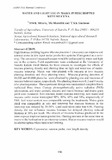Water and light use in maize intercropped with Mucuna

View/
Date
2011-09Author
Gachene, C. K. K.
Mureithi, J. G.
Mburu, M.W. K.
Language
enMetadata
Show full item recordAbstract
High biomass yielding legume Mucuna pruriens L (mucuna) can improve soil
nutrient status in low input maize production systems if integrated as a cover
crop. The amount of mucuna biomass would be influenced by water and light
use in the systems. Field experiments were conducted at the University of
Nairobi Kabete Field Station for three seasons to investigate the effects of
mucuna planting density and planting time on light and water use of maizemucuna
intercrop. Maize was inter-planted with mucuna at two mucuna
planting densities and three planting times. Mucuna planting densities of
44,000 and 88,000 plants ha' were obtained by planting one and two rows of
mucuna between maize, respectively. The planting times were 0, 2 and 4 weeks
after planting maize. The experiment design was randomized complete block
replicated three times. Canopy photosynthetically active radiation (PAR)
interception, soil water content, mucuna and maize biomass and maize grain
yield were measured. Sole mucuna, maize-mucuna intercrop, sole maize and
mucuna under maize intercepted 90%, 80%, 65% and 30%, respectively of
PAR. Soil water content was comparable among the treatments. Maize grain
yield was comparable in sole and intercrop but mucuna biomass in the
intercrop was reduced by 26-56%. Land equivalent ratio was 0.96. Planting
density did not influence mucuna biomass but delayed planting reduced
biomass at 10% per week. The amount of mucuna biomass produced in the
intercrop can improve maize production. Planting mucuna at the same time as
maize is the best option in an intercrop system. Maize-mucuna rotation would
be a better option where land is not limiting.
Citation
Optimimization of Agricultural Value Chains for sustainable DevelopmentSponsorhip
National Council of Science and Technology, The Kenya Seed CompanyPublisher
Faculty of Agriculture, University of Nairobi
Description
Oral presentation at aGRO 2011 Biennial Conference
